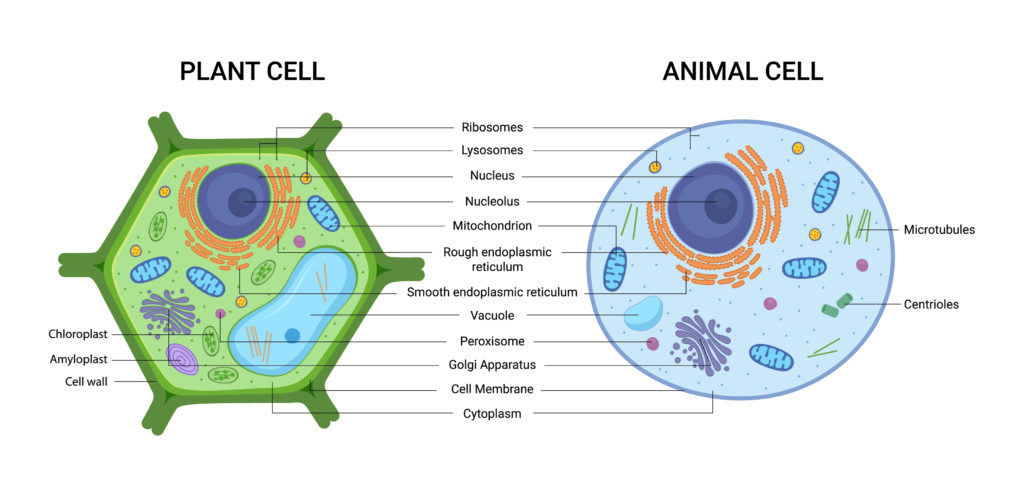Plant vs Animal cells
Plants, like animals, have eukaryotic cells – meaning they possess a defined nucleus and membrane-bound organelles.
Although they share many common features, they have 2 main differences.
First, plant cells have a cell wall that surrounds the cell membrane – animal cells do not. This allows them to form an upright structure without the need for a skeleton. Second, they have two organelles that animal cells lack – chloroplasts, and a large central vacuole. These allow them to produce their own food through photosynthesis.

Typical plant and animal cell comparison
Inside a Plant Cell
So what’s inside these cells you ask ! Check out the diagram below :

Diagram of a plant cell
Cytoplasm
This is the liquid that everything floats in which allow things to move around as needed.
Cyclosis (cytoplasmic streaming) is the process where chloroplasts move around inside the cell to obtain the best possible light from the sun !
Google cytoplasmic streaming – its fascinating to watch !
Organelles
Chloroplasts
This is a complex sugar producing organelle made of several disk layers loaded with the photosynthetic pigment we call chlorophyll.

Chloroplasts near the air pores (stoma).
Chromoplasts
A place where colors are chemically manufactured for the flowers, fruits or tissue that need them.

Nucleus
Basically – the library of everything – for the storage of DNA.
Endoplasmic reticulum
A manufacturing center for proteins (with the help from ribosomes) and lipids.
Golgi apparatus
Great name ! – what it does is store the synthesized proteins and fats in the cell then delivers them where needed like of like a food delivery service.
Ribosomes
Tiny organelle that synthesized proteins by reading the DNA (or actually a simpler copy called RNA).
Mitochondria
The energy maker! Converts raw materials ( CO2 + H2O ) into usable energy.
Vacuole
A big storage tank of food and water that also regulates internal pressure – it is the basic structure needed to keep plants upright !
Lysosomes !!! MY FAVORITE OF THEM ALL !
These hold digestive enzymes that usually perform the function of cellular waste disposal. They digest worn-out organelles, food particles and foreign bodies in the cell – kind of like an amoeba! They attach themselves then release their digestive enzymes.
BUT – if the cell itself is attacked by a something (Virus, bacteria, fungus) they rupture inside the cell and LIQUIFY everything – the good, the bad and the ugly all at once !

If you want to learn about plants – Call Plant Specialists TODAY !
Our experts can teach you many fascinating things!
Don’t delay – the sooner the better !
GREENING NEW YORK FOR OVER 51 YEARS !
Article written by our Staff Horticulturist, Peter B Morris, BSc, MSc, MBA
All photographs used with permission @SHUTTERSTOCK
